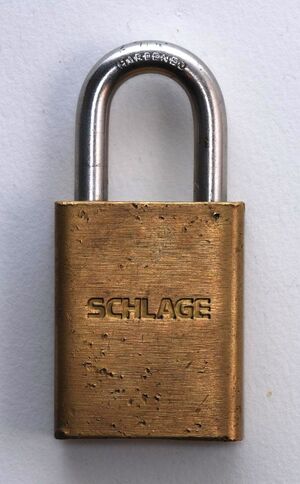Padlock: Difference between revisions
From Lockwiki
Jump to navigationJump to search
No edit summary |
m (Reverted edits by 205.215.175.102 (Talk) to last revision by 76.127.177.119) |
||
| Line 6: | Line 6: | ||
[[File:Schlage padlock.jpg|thumb|right|text-top|A [[Schlage]] brand brass body padlock.]] | [[File:Schlage padlock.jpg|thumb|right|text-top|A [[Schlage]] brand brass body padlock.]] | ||
A '''padlock''' is a portable [[lock]] used to restrict access to an area or enclosure or prevent an object from being removed from an area | A '''padlock''' is a portable [[lock]] used to restrict access to an area or enclosure or prevent an object from being removed from an area. Padlocks are widely used in everyday life in both low and high security installations. In popular use, padlocks are used on lockers, gates, fences, hasps, and chains to secure a wide variety of objects and areas. | ||
Padlocks can use a variety of locking designs, but [[pin-tumbler]] and [[warded]] mechanisms are the most common. [[Lever]] padlocks were also popular at one time, but use has dwindled in most parts of the world in favor of pin-tumbler or warded mechanisms. | Padlocks can use a variety of locking designs, but [[pin-tumbler]] and [[warded]] mechanisms are the most common. [[Lever]] padlocks were also popular at one time, but use has dwindled in most parts of the world in favor of pin-tumbler or warded mechanisms. | ||
Revision as of 15:56, 7 September 2011
Padlock
| This article may require cleanup to meet Lockwiki's quality standards. Please improve this article if you can. |

A Schlage brand brass body padlock.
A padlock is a portable lock used to restrict access to an area or enclosure or prevent an object from being removed from an area. Padlocks are widely used in everyday life in both low and high security installations. In popular use, padlocks are used on lockers, gates, fences, hasps, and chains to secure a wide variety of objects and areas.
Padlocks can use a variety of locking designs, but pin-tumbler and warded mechanisms are the most common. Lever padlocks were also popular at one time, but use has dwindled in most parts of the world in favor of pin-tumbler or warded mechanisms.
History
Add to me!
Parts of a padlock
- shackle, bolt
- A rod made of a hardened material (typically steel) that is affixed to an object, usually a hasp, fence, or chain. The shackle is responsible for keeping the padlock connected to whatever it is attached to. This is the weakest part of the padlock in forced entry as the unprotected bolts can often be cut using bolt cutters. See bolt for more information.
- body
- The part of the padlock that surrounds the locking mechanism and most of the shackle. More secure padlocks attempt to conceal as much of the shackle as is possible to prevent various forms of forced entry. Padlocks designed in this manner are referred to as shrouded.
- locking mechanism
- The component that restricts the shackle until the correct key or combination is used. Modern padlocks do not interface directly with the shackle but instead use an actuator to do so. Pin-tumbler and warded locking mechanisms are the most popular on padlocks worldwide. Many padlocks use locking designs that provide a key retaining mechanism.
- shroud
- The portion of a padlock body that covers or conceals the shackle or bolt. Padlocks that use a shroud are referred to as "shrouded" and help defend against certain forms of destructive entry.
Gallery
Yale HSS50 dimple padlock.
Common Master Lock padlock.
A shrouded Brinks brand padlock.
The ABUS Plus padlock.







